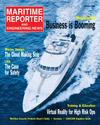
Page 50: of Maritime Reporter Magazine (October 2005)
The Marine Design Annual
Read this page in Pdf, Flash or Html5 edition of October 2005 Maritime Reporter Magazine
50 Maritime Reporter & Engineering News
Crews operating in high-risk environ- ments rely on their training to operate effectively and save lives. However, it is precisely in these environments that realistic and effective training is often difficult, dangerous or costly.
Fairmount's safety training subsidiary,
VSTEP, helps maritime and offshore companies prepare their crews for the unknown.
The U.S. military also faced this dilemma and found the solution in virtu- al reality simulations. Rapid advances in computer gaming technology, have given rise to a new generation of realis- tic non-entertainment applications.
These "serious games" as they are called, focus on delivering better ways of learning, allowing people to experi- ence life-like situations.
How Does it Work?
The software runs on a standard PC. A realistic 3-D model of the actual work- ing environment forms the basis of a vir- tual experience for trainees. The 3-D environment can be an exact replica of a geographic area, needed for military training, but also a vessel, oil rig, indus- trial plant, tunnel, or train.
Within the virtual environment, inci- dents are simulated including any ele- ment of a real situation, such as fire, smoke, panic or casualties. The trainee experiences these incidents as if he was actually there, and must respond to the situation as he would in real life. Using the mouse or joystick, he is free to move around, make decisions, communicate with others and take appropriate action.
The trainee is directly confronted with the consequences of his decisions.
As a result of powerful visuals, active participation and direct feedback, people learn faster and remember procedures better. Being able to repeat incident sce- narios over and over, shapes behaviour and develops competencies.
Virtual Reality Supplements Practical
Training
The key benefits of virtual reality sim- ulations are the ability to realistically experience an incident situation over and over again, the interactivity and the low cost. Serious games are unlikely to replace real-life practical training 100 percent, but they allow trainees to train specific decision-making skills and experience situations before real-life training. This makes the real-life train- ing more valuable and cost-effective.
For example, training Helicopter
Landing Officers on offshore installa- tions to take appropriate action in emer- gencies is dangerous and costly.
Allowing them to practice different landing scenarios in a virtual environ- ment before going out to experience extinguishing a real helicopter, makes the practical training more effective.
VSTEP develops custom training courses for emergency services, ship owners, offshore operators, port author- ities, hospitals, military and training institutes. Recent projects include: • Incident configurator for the
Rotterdam Port Authority. Instructors configure an incident on the PC: in dif- ferent parts of the harbor, vessel types, incidents, weather types, etc. Port safety crews then take over and need to demon- strate what actions they would take.
Training & Education
Virtual Reality Preps Crews for High-Risk Ops
In VSTEP's recent Office Emergency Response training, people experience incidents like a fire. They need to decide what's most important: ring the alarm bell, call the company safety officer, send the staff to the assembly point, or kill the fire him- or herself.
In the Incident Configurator tool that VSTEP made for the Port of Rotterdam authorities, an instructor can configure an incident to his preference. He can choose from three ship types, set the location (inside the harbour or on open sea), and set some weather conditions like wind direction and force. Students subsequently experience the incident from a viewpoint of an incident response ship. In a class- room, they discuss the best way of attacking the fire.
MR OCTOBER 2005 #7 (49-56).qxd 9/29/2005 8:57 AM Page 50

 49
49

 51
51
